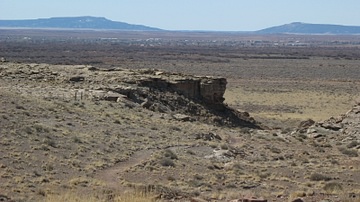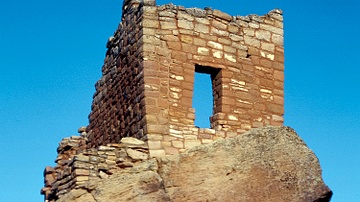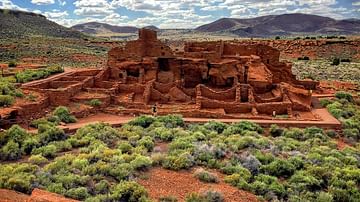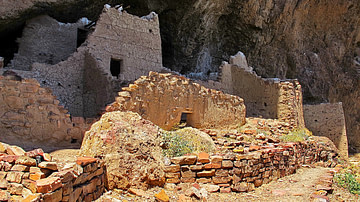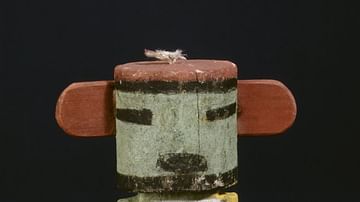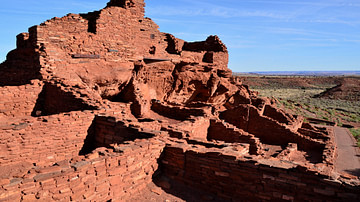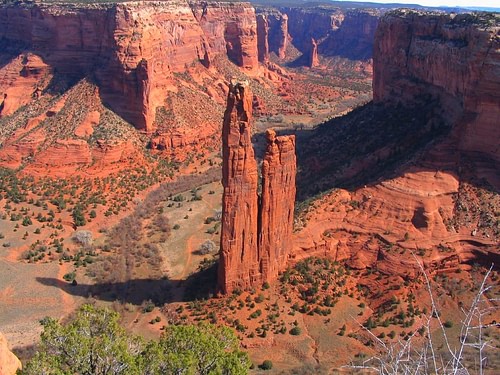
Canyon de Chelly or Canyon de Chelly National Monument is a protected site that contains the remains of 5,000 years of Native American inhabitation. Canyon de Chelly is located in the northeastern portion of the US state of Arizona within the Navajo Nation and not too far from the border with neighboring New Mexico. It is located 472 km (293 miles) northwest of Phoenix, Arizona. Canyon de Chelly is unique in the United States as it preserves the ruins and rock art of indigenous peoples that lived in the region for centuries - the Ancestral Puebloans and the Navajo. Canyon de Chelly has been recognized as a US National Monument since 1931 CE, and it is one of the most visited National Monuments in the United States today.
Geography & Prehistory
The etymology of Canyon de Chelly's name is unusual in the U.S. Southwest as it initially appears to resemble French rather than the more ubiquitous Spanish. "Chelly" is actually derived from the Navajo word tseg, which means "rock canyon" or "in a canyon." Spanish explorers and government officials began to utilize a "Chelly,” “Chegui,” and even "Chelle" in order to try to replicate the Navajo word in the early 1800s CE, which eventually was standardized to “de Chelly” by the middle of the 19th century CE.
Canyon de Chelly lies very close to Chinle, Arizona, and it is located between the Ancestral Puebloan ruins of Betakin and Kiet Siel in the west and the grand structures of Chaco Canyon in New Mexico in the east. Canyon de Chelly, as a National Monument, covers 83,840 acres (339.3 km2; 131.0 sq miles) of land that is currently owned by the Navajo tribe. Spectacularly situated on the Colorado Plateau near the Four Corner's Region, Canyon de Chelly sits at an elevation of over 1829 m (6,000 ft) and bisects the Defiance Plateau in eastern Arizona. The tributaries of the Chinle Creek, which runs through Canyon de Chelly and originates in the Chuska Mountains, have carved the rock and landscape for thousands of years, creating red cliffs that rise up an additional 305 m (1000 ft). The National Monument extends into the canyons of de Chelly, del Muerto, and Monument.
Canyon de Chelly is one of the longest continuously inhabited places anywhere in North America, and archaeologists believe that human settlement in the canyon dates back some 5,000 years. Ancient prehistoric tribes and peoples utilized the canyon while hunting and migrating seasonally, but they did not construct permanent settlements within the canyon. Nonetheless, these prehistoric peoples did leave etchings on stones and on canyon walls throughout what is now Canyon de Chelly. Around c. 200-100 BCE, peoples following a semi-agricultural and sedentary way of life began to inhabit the canyon. (Archaeologists refer to these peoples as "Basketmakers." They are considered the ancestors to the Ancestral Puebloan Peoples.) While they still hunted and gathered like their prehistoric forebears, they also farmed the land where fertile, growing corn, beans, squash, and other small crops. It is also known that they grew cotton for textile production. Yucca and grama grass have grown in the canyon for several millennia, and indigenous people utilized these plants when making baskets, sandals, and various types of mats. Prickly pear cactus (Opuntia cactaceae) and pinyon are also found throughout Canyon de Chelly, the latter of which provided an important source of food for indigenous peoples in autumn and winter. Fish are found in Canyon de Chelly's tributaries, and large and small game frequent the canyon.
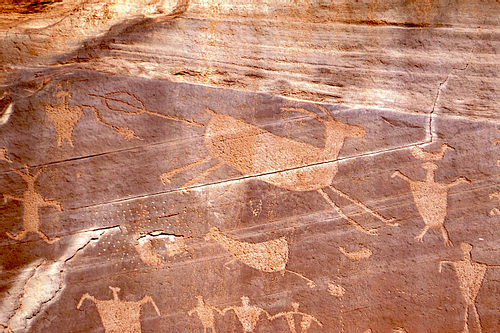
Ancestral Puebloans in Canyon de Chelly
A cultural shift around c. 700 CE occurred when the Ancestral Puebloan peoples (Anasazi) began to build larger settlements of cliff dwellings within Canyon de Chelly. Abandoning their smaller pit houses, which were formerly located on top of cliffs in Canyon de Chelly, the Ancestral Puebloan people constructed compounds of apartment-like buildings made with adobe brick blocks or stone blocks. The Ancestral Puebloan people constructed these cliff dwellings or houses in places where there were numerous overhanging cliffs within what is present-day Canyon de Chelly. It has been suggested that during the 1000s CE, there was a small migration of people from the San Juan Basin in what is present-day Colorado and New Mexico who brought their own artistic styles and architectural models to Canyon de Chelly.
In its heyday, Canyon de Chelly had between 600-800 people around c. 1150 CE, and many archaeologists and anthropologists believe that the Ancestral Puebloan ruins in Canyon de Chelly can be considered as a Chacoan outlier community. One curiosity regarding the Ancestral Puebloan cliff dwellings at Canyon de Chelly, however, when compared to those at Chaco Canyon or Mesa Verde National Park, is the paucity of kivas (underground or semi-underground chambers) and the coarser approach to stone masonry. The earliest rooms of these residential cliff compounds initially contained storage spaces, but the Ancestral Puebloan people later built other dwellings over and next to these storage units to conserve space. The cliff dwellings in Canyon de Chelly are composed of multistoried and terraced units that were accessible via wooden ladders. Within a compound, access between floors was made possible by log rafters. Some walls had keyholes and quadrilateral-shaped doorways, and a few cliff dwellings even had square windows. Certain spaces were left open, and the Ancestral Puebloan people dug kivas, which were used as ritual spaces for ceremonial events and social meetings.
White House Ruins & Mummy Cave
Of the Ancestral Puebloan sites within Canyon de Chelly, two are especially noteworthy: White House Ruin and Mummy Cave. Other ruins include Antelope House, which is renowned for its ancient paintings of antelope. White House Ruin is one of the most interesting and recognizable Ancestral Puebloan ruins in the desert Southwest. Its name denotes the distinctive white plaster, which decorates the ruin's back wall in the upper part of the dwelling. White House Ruin is a cliff dwelling connected to a four-story block on the base of a 150 m (500 ft) cliff 3 km (2 miles) east of Canyon de Chelly's dramatic junction with Canyon del Muerto. White House Ruin contains the remains of several circular kivas, and the size and scale of the building's upper stories of the ruin are reminiscent of those at Chaco Canyon. Dendrochronology (tree-ring dating) leads scholars to believe that White House Ruin was inhabited from c. 1060-1275 CE and that the ruins once housed approximately 100 people.
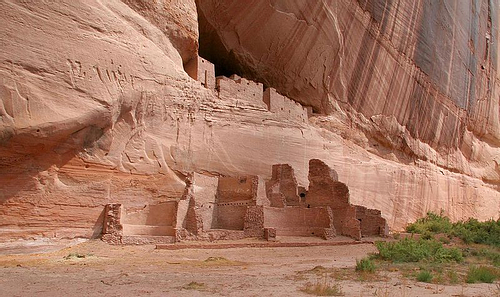
The Mummy Cave lies some 90 m (300 ft) above the tributary bed of the Canyon del Muerto, and it is located some 16 km (10 miles) east from the White House Ruins. Mummy Cave once provided shelter to about 60-75 people. The Mummy Cave's earliest structures are located in the eastern cave, which date from c. 300-400 CE although construction continued over the centuries. A total of 45 rooms existed in the eastern cave, but this number may have been higher. An impressive three-story tower is located near the eastern cave. A 30 m (100 ft) ledge building connects the eastern cave to the western cave, and the room sizes here resemble those found in Mesa Verde National Park in Colorado rather than others found within Canyon de Chelly. A wooden beam in this structure dates to c. 1284 CE, and it is possible that the final architects and occupants at Mummy Cave were originally from Mesa Verde after it was abandoned in c. 1250 CE. The western cave has 14 rooms and likely had more in ancient times. Scholars and archaeologists believe that due to the lack of kivas in the western cave, the eastern part of the cave is where ceremonies and social meetings took place. Altogether some 70 rooms have been uncovered at Mummy Cave, and there are also at least three kivas.
Later History & Navajo Occupation
The abandonment of the Ancestral Puebloan structures at Canyon de Chelly around c. 1300 CE remains an enduring mystery. Over the past century, archaeologists, historians, and scientists have tried to pinpoint the root causes of the massive abandonment of settlements like Hovenweep, Chaco Canyon, and Mesa Verde, but there is no single consensus among experts. Whether due to internecine warfare, severe drought and food shortages as a result of unfavorable climatic conditions, infectious diseases or the emergence of new religious and cultural centers, Canyon de Chelly's inhabitants left the area and migrated in a southerly direction towards the more fertile Rio Grande Valley in what is present-day New Mexico and the Little Colorado River Basin in what is present-day Arizona. Their descendants - the Pueblos of New Mexico, the Zuni, and the Hopi - are the inheritors of their rich traditions in artistic and architectural design.
The Hopi continued to visit and partake in rituals in Canyon de Chelly from c. 1300-1700 CE, and they still revere the ruins today. The Navajo arrived in the region in the late 17th century CE, and they occupy the region today. Lt. Antonio Narbona (1773-1830 CE) led the Spanish to victory over the Navajo at a battle in Canyon de Chelly in 1805 CE. Another battle took place in Canyon de Chelly in 1863 CE when the U.S. Colonel Kit Carson (1809-1868 CE) fought against the Navajo, defeating them again.

